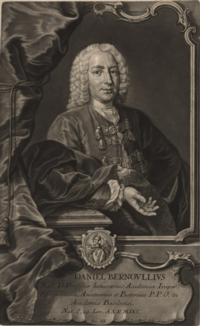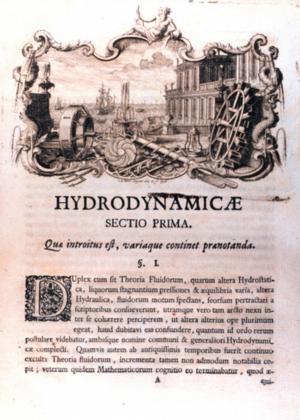Daniel Bernoulli
The most famous mathematician of the Bernoulli family, b. 8 February (29 January*) 1700 (Groningen, Netherlands), d. 17 March 1782 (Basel, Switzerland).
 Daniel Bernoulli came from a famous Swiss family of mathematicians that included his father Johann and his uncle Jakob. Daniel studied philosophy, logic and medicine at the universities of Heidelberg, Strasbourg and Basel, but his first major work after receiving his M.Sc. was Exercitationes quaedam Mathematicae, a treatise on differential equations related to the physics of flowing water (fluid dynamics).
Daniel Bernoulli came from a famous Swiss family of mathematicians that included his father Johann and his uncle Jakob. Daniel studied philosophy, logic and medicine at the universities of Heidelberg, Strasbourg and Basel, but his first major work after receiving his M.Sc. was Exercitationes quaedam Mathematicae, a treatise on differential equations related to the physics of flowing water (fluid dynamics).
The work brought him an invitation to the Russian Academy of Science in Saint Petersburg, where he lectured in medicine, mechanics and physics. His name was soon well known in Europe, and in 1732 he accepted a position in Basel to teach anatomy and botany.
Bernoulli's major work Hydrodynamica appeared in 1738. It laid out the principles of fluid dynamics, i.e. the movement of a fluid under the influence of forces. It developed the relationship between fluid velocity, pressure and density. It established what is now known as Bernoulli's theorem, that the pressure in a fluid decreases as its velocity increases.
Bernoulli developed the basis for the kinetic energy of gases by showing that pressure in a gas can be explained by random collisions of molecules with the container and that pressure and particle movement increase with temperature.
Bernoulli's interest covered many areas of science. Between 1725 and 1749 he won 10 prices from the French Academy of Sciences for work on astronomy, gravity, tides, magnetism and ocean currents. As a result his appointment in Basel was moved to physiology in 1743 and to physics in 1750.
Daniel Bernoulli's success generated the envy of his father Johann, with whom he shared the Academy price in 1735 for work on planetary orbits. Johann Bernoulli felt that he should have received the price alone. In an attempt to increase his own standing over his son, he published a work entitled Hydraulica in the same year when Daniel Bernoulli's Hydrodynamica appeared, but without much impact.
The Bernoulli theorem is the basis for aircraft design: The wings of an aircraft are formed such that the air moves faster above it than below it. As a consequence the air pressure over the wing is less than the air pressure under the wing. The pressure difference creates an upward directed force that lifts the aircraft.
* Dutch date of the time. The Gregorian calendar used in other parts of Europe came into force in Groningen at a later date.
The title page and the first page of the first part of Bernoulli's Hydrodynamica.


home
 Daniel Bernoulli came from a famous Swiss family of mathematicians that included his father Johann and his uncle Jakob. Daniel studied philosophy, logic and medicine at the universities of Heidelberg, Strasbourg and Basel, but his first major work after receiving his M.Sc. was Exercitationes quaedam Mathematicae, a treatise on differential equations related to the physics of flowing water (fluid dynamics).
Daniel Bernoulli came from a famous Swiss family of mathematicians that included his father Johann and his uncle Jakob. Daniel studied philosophy, logic and medicine at the universities of Heidelberg, Strasbourg and Basel, but his first major work after receiving his M.Sc. was Exercitationes quaedam Mathematicae, a treatise on differential equations related to the physics of flowing water (fluid dynamics).
